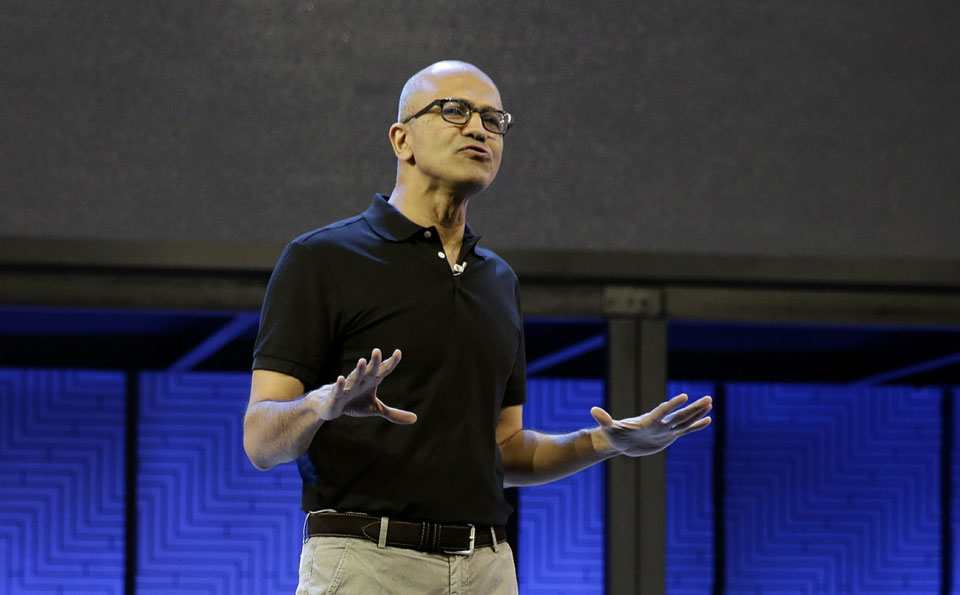Microsoft CEO Satya Nadella is the most successful CEO of the Tech industry

Satya Narayana Nadella became Microsoft’s Chief Executive Officer (CEO) in 2014. At that time, the corporation’s market capitalization was around $311 billion. Microsoft is now worth more than $2.26 trillion. Microsoft was among the first companies to exceed a $1 trillion valuation when it hit that milestone in April 2019. Another noteworthy aspect is that at that time, the cloud was not a key element of the company’s strategy as the primary focus was on “consumer and devices” segments.
Microsoft was viewed as a company whose best days were in the past. Within 7 seven years of his leadership, Nadella’s firm leadership transformed Microsoft into a dominant cloud services provider and the second most-valuable corporation globally, only behind Apple Incorporated. Overall, Nadella has hugely transformed the corporation using his leadership approach characterized by a clear vision, open and clear communication, courage, humility, empathy, and capacity to generate energy among teams.
In the years immediately before Nadella assumed the office as the CEO, Microsoft’s commercial cloud business was not part of its key business. It was classified under “other” sources of revenue. Today, the enterprise’s cloud business has become the key element in its quarterly revenue reports and the key highlight for the same press release. The company’s cloud business accounted for as much as 42% of its total revenue as of 2021. In the 2021 financial year, quarter 3, the company’s total revenue was 41.7 billion, whereby, out of this, commercial cloud generated $17.7 billion. Without a doubt, Nadella’s leadership skills and approach made the company transform from having cloud business from the category of “other” revenue sources to making it the keystream of revenue for the corporation. The key leadership skills and approaches that have made Nadella such a successful CEO in the technology industry and across the world are as discussed below.
Nadella has a clear vision as a leader. While always expressing due respect to the CEO he replaced, Nadella immediately resorted to getting the corporation out of its mobile phones business into a new category of cloud business. He promoted this clear vision to all employees at Microsoft on regular bases. He did not keep this vision into a small group or team within the organization; he shared it with everyone to keep them informed, motivated, and part of the mission (Allio, 2015). Nadella regularly communicates with all Microsoft employees worldwide to share his vision or plans for the corporation and invite feedback. He routinely sends company-wide emails explaining his ideas for the company’s future, not only corporate issues. Communicating the vision to all employees ensures clarity at all levels. At the time of chaos, crisis, or change, employees look up to those in leadership to offer clarity and guide their actions, and realizing this, Nadella resorted to utilizing his amazing capability of bringing order and clarity into this new company direction (Ancona, Williams & Gerlach, 2020). This trait was part of his reasons why he managed to bring success to the corporation, and it demonstrates the need for a leader to have a clear vision and get everyone in the organization to buy the vision and strategy.
Nadella has also shown his ability to generate energy throughout the organization. Offering clarity and precision is extremely helpful, but it was not enough to bring the success that Nadella envisioned for the company. In addition, Nadella wanted to generate energy throughout the organization by ensuring that the employees, especially top leaders, had genuine enthusiasm and passion for what the company was about to do (Agnihotri & Bhattacharya, 2021). Upon assuming office as the CEO, Nadella initiated notable sweeping reorganizations that set the company on the pathway for success in the cloud business. Initially, the company’s marketing and development teams used to compete against each other, creating a sluggish attitude and complacency within the company (Allio, 2015). Such a move was meant to create energy by bringing teams and people together and ensuring that everybody was passionate and united to pursue the new direction. Without good chemistry between leaders and collaboration between departments, the company’s revenue would have continued to dwindle. Nadella employed his team leadership and people skills to create energy and unite these departments into customer-focused and collaborative ones.
Nadella has also changed the company culture from that characterized frequent high-intensity rants and ravings to one focused on customers. Instead of continuing with the precision questioning approach employed by his predecessors, Nadella created a new culture focused on consumers’ challenges, opportunities, problems, aspirations, dreams, and needs (Ancona, Williams & Gerlach, 2020). To attain this intense focus on the consumers, Nadella relentlessly changed the organizational structures to encourage other leaders to focus on consumer engagements and use innovative language to express the company’s priorities and values (Ancona, Williams & Gerlach, 2020). An example is whereby he encouraged consumers to be tech-intensive, meaning that they not only purchase Microsoft’s services and software but also build their software. The company established beneficial partnerships with the customers and other external stakeholders, which increased its global sales.
Nadella is a courageous leader who is not afraid to take risks. Such a character is evident in the fearless acquisitions he engineered as the CEO. According to Evans (2021), such acquisitions included LinkedIn in 2016 and GitHub in 2018. Each of the many acquisitions was a fearless one from the CEO’s point of view. They signaled a pivotal direction for the corporation as the acquired companies were at the forefront of new technologies (Ancona, Williams & Gerlach, 2020). For instance, the LinkedIn acquisition enabled Microsoft to exploit the social-media aspects of professional networks, while the GitHub one enabled the company to supercharge its developer community. Such kinds of acquisitions depict Nadella as a bold decision-maker and a prompt executor who understands what he wants to do for the company, and this makes him recognize what would propel the company towards its mission quickly.
Nadella also employs empathy and embodies the growth mindset. This mindset encompasses the conviction that challenges are opportunities for people to grow, change, and learn new skills. As the CEO, Nadella encourages all Microsoft employees to embrace the “learn-it-all” approach and experience innovative ideas and passion projects (Ancona, Backman & Isaacs, 2019). In case of employee mistakes, Nadella employs a gentle and empathetic approach meant to encourage the employees to re-think their designs and approach the challenge from a different dimension (Athota, 2021). Overall, Nadella has been known to utilize employees’ mistakes as opportunities to grant them a second chance to learn, grow, and re-think their ideas.
In addition to empathy, Nadella is a humble person and a people-oriented leader. He uses his humility to the success of Microsoft. Nadella begins by encouraging employees to showcase their success in senior leadership meetings. Employees join the leadership team’s meetings via video to showcase their developments, which acts as an inspiration for the senior leaders. Instead of focusing on himself or the top leaders, Nadella shares his employees’ success, demonstrating leadership humility. Such a practice can inspire top leaders while motivating employees to work harder to become part of the senior leadership team or gain recognition. Such practice implies that leading a top corporation should not come with an inflated ego. A big ego could be detrimental to the company’s success as other people may feel that their leader is authoritative, not approachable, their efforts are not recognized, or their ideas are not valued or needed. Instead of having a big ego, a leader of such a big corporation should put people first to ensure that diverse ideas are encouraged, and people at any level of the organization feel included and part of the big picture (Prakash, Bisla, & Rastogi, 2021). Such a humble approach of valuing each employee’s ideas and encouraging them to do their best has helped Nadella create a culture of collaboration and innovation at Microsoft (Ancona, Backman & Isaacs, 2019). This culture has been a key reason for the corporation’s turnaround since he took the helm.
In conclusion, key leadership skills such as empathy, humility, thinking big, caring for people, prompt execution, courage, and a growth mindset have been instrumental to Nadella as Microsoft’s CEO. Such leadership capabilities have helped Nadella turn around the company from one thought to be on a downward spiral to an industry leader in technology in terms of market capitalization. The vision and the huge bet on cloud computing that Nadella made for the company are expected to generate more and more revenue for the corporation and continue being the mainstream business even after his retirement. Other leaders can learn from Nadella that having a great vision, explaining it to all employees, and creating harmony and collaboration among teams is crucial to a company’s success. In addition, skills such as empathy, humility, employee engagement, promoting diversity of ideas, and employing a growth mindset are invaluable skills for leaders in this age when employees face many challenges at the workplace.
References
Agnihotri, A., & Bhattacharya, S. (2021). Satya Nadella: Leading Microsoft’s Growth. SAGE Publications: SAGE Business Cases Originals.
Allio, R. J. (2015). Good strategy makes good leaders. Strategy & Leadership, 43(5), 3-9. https://doi.org/10.1108/sl-07-2015-0059
Ancona, D., Backman, E., & Isaacs, K. (2019). Nimble leadership. Harvard Business Review, 97(4), 74-83. https://empowerment.ee/wp-content/uploads/2021/02/Nimble-Leadership-Walking-the-line-between-creativity-and-chaos-1.pdf
Ancona, D., Williams, M., & Gerlach, G. (2020). The overlooked key to leading through chaos. MIT Sloan Management Review, 62(1), 34-39. https://provost.uiowa.edu/sites/provost.uiowa.edu/files/2021-05/Sensemaking%20MITSloan.pdf
Athota, V. S. (2021). Impact of Fixed vs. Growth Mindset in Organizations. In Mind over Matter and Artificial Intelligence (pp. 29-37). Palgrave Macmillan, Singapore.
Evans, B. (2021, June 21). Microsoft CEO Satya Nadella is world’s #1 CEO: 5 reasons why. Acceleration Economy. https://accelerationeconomy.com/cloud/microsoft-ceo-satya-nadella-is-worlds-1-ceo-5-reasons-why/
Prakash, D., Bisla, M., & Rastogi, S. G. (2021). Understanding authentic leadership style: The Satya Nadella Microsoft approach. Open Journal of Leadership, 10(02), 95-109. https://doi.org/10.4236/ojl.2021.102007
Add CEOWORLD magazine to your Google News feed.
Follow CEOWORLD magazine headlines on: Google News, LinkedIn, Twitter, and Facebook.
This report/news/ranking/statistics has been prepared only for general guidance on matters of interest and does not constitute professional advice. You should not act upon the information contained in this publication without obtaining specific professional advice. No representation or warranty (express or implied) is given as to the accuracy or completeness of the information contained in this publication, and, to the extent permitted by law, CEOWORLD magazine does not accept or assume any liability, responsibility or duty of care for any consequences of you or anyone else acting, or refraining to act, in reliance on the information contained in this publication or for any decision based on it.
Copyright 2024 The CEOWORLD magazine. All rights reserved. This material (and any extract from it) must not be copied, redistributed or placed on any website, without CEOWORLD magazine' prior written consent. For media queries, please contact: info@ceoworld.biz
SUBSCRIBE NEWSLETTER








